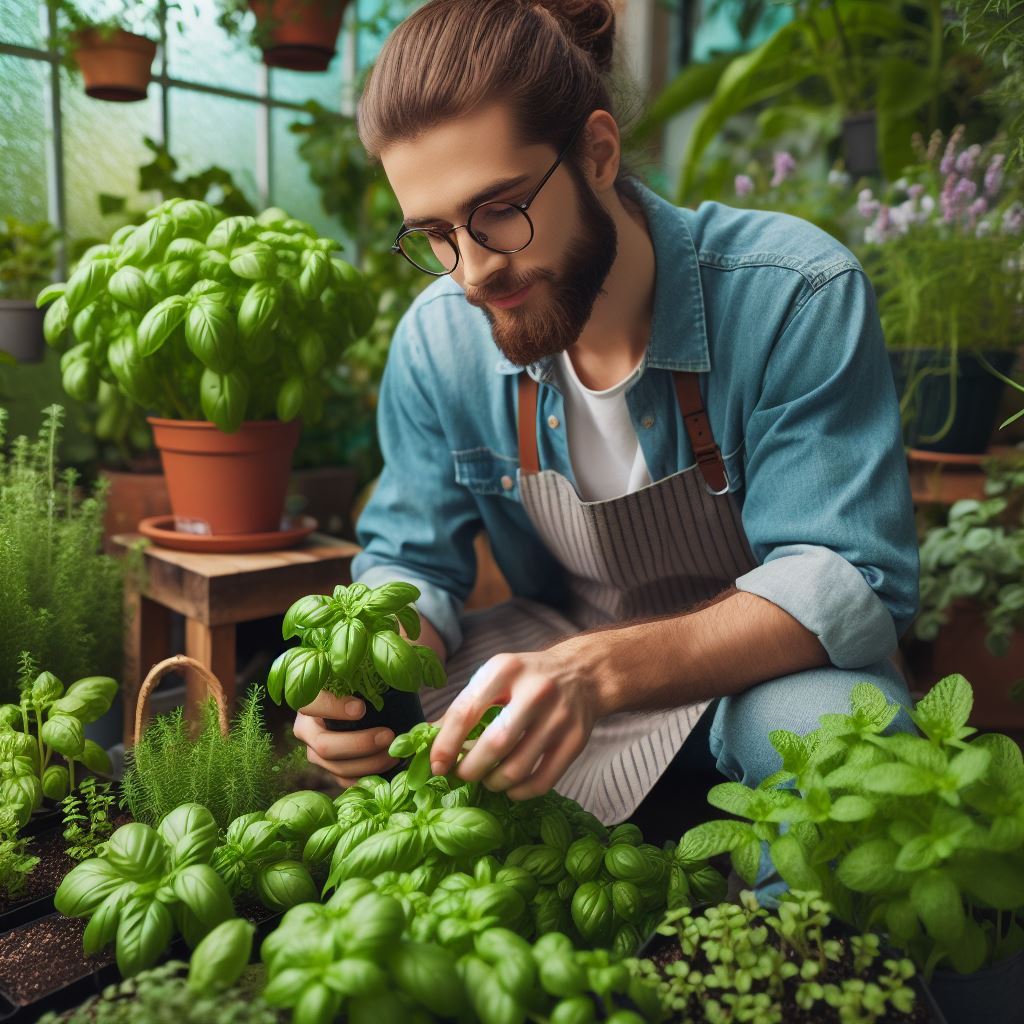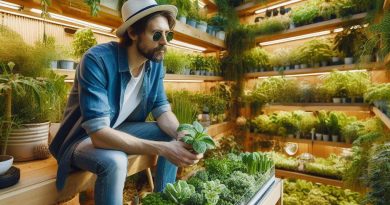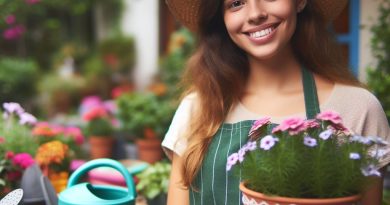Indoor Herb Magic: Grow Basil, Mint & More
Last Updated on March 2, 2024
Introduction
Experience the enchantment of indoor herb gardening with Grow Indoor Herb Basil Mint, as you elevate your culinary artistry and fill your home with vibrant aromas.
This practice transcends seasonal limitations, allowing you to cultivate a diverse array of flavorful herbs throughout the year.
Imagine snipping fresh basil for an authentic pesto, infusing summer cocktails with the invigorating essence of mint, or garnishing dishes with vibrant rosemary sprigs.
Indoor herb gardens offer a multitude of benefits beyond enhancing culinary creations.
These miniature ecosystems bring life and a touch of nature indoors, fostering a sense of serenity and promoting improved air quality.
Convenient access to fresh, potent herbs elevates the taste and nutritional value of your meals, while promoting sustainable living practices.
This comprehensive guide empowers you to cultivate a thriving herb haven, regardless of space limitations or prior experience.
We’ll delve into selecting the perfect herbs, choosing suitable containers, and creating an ideal growing environment for your culinary companions.
Unleash your inner gardener and embark on a rewarding journey of flavor and sustainable living.
Getting Started with Indoor Herb Gardens
Starting an indoor herb garden is a great way to bring fresh flavors and greenery into your home.
Whether you have a large space or just a small window sill, you can enjoy the magic of growing your own herbs. To ensure success, follow these steps:
Choose the best herbs for indoor cultivation
Not all herbs thrive in indoor settings.
Some herbs require full sun and grow better outdoors.
Choose herbs like basil, mint, parsley, and chives that are well-suited for indoor conditions.
Select the right containers and soil
Choosing the right containers is crucial for the health and growth of your herbs.
Opt for containers with good drainage to prevent root rot.
Use a high-quality potting mix that provides adequate nutrients and drainage.
Provide proper lighting and temperature
Herbs need plenty of light to thrive.
Place your indoor herb garden near a window that receives at least 6 hours of direct sunlight each day.
If natural light is limited, consider using artificial grow lights.
In addition to lighting, temperature is also important.
Most herbs prefer temperatures between 60-70°F.
Avoid placing your herb garden near drafty windows or heat sources.
By following these steps, you can create an indoor herb garden that will provide you with fresh herbs year-round.
Having the right herbs, containers, soil, lighting, and temperature is essential for a successful indoor herb garden.
By selecting herbs that are compatible with indoor conditions, providing proper containers and soil, and ensuring adequate lighting and temperature, you can enjoy the taste and beauty of fresh herbs in your home.
So what are you waiting for? Start your indoor herb garden today and experience the magic of growing your own herbs!
Read: Easy Herbs for Window Gardening Success
Growing Basil Indoors
Introduction to basil as an indoor herb
Basil is a versatile herb that can thrive indoors, bringing fresh aroma and flavor to your cooking.
Growing herbs indoors allows you to enjoy their benefits year-round, even in small spaces.
Tips for starting basil from seeds or transplants
- Start basil from seeds by filling a seed tray with moistened potting soil.
- Place the seeds on the soil surface, covering lightly with a thin layer of soil.
- Keep the soil consistently moist but avoid overwatering to prevent root rot.
- Transplants can be purchased from nurseries and garden centers if you prefer not to start from seeds.
- When transplanting, gently remove the basil plant from its container and place it in a larger pot.
- Ensure the new pot has good drainage to prevent waterlogging.
- Water the transplant thoroughly and place it in a sunny location to promote growth.
Ideal growing conditions for basil
- Basil prefers bright, direct sunlight for at least 6 to 8 hours a day.
- Maintain a temperature range of 60-70°F (15-21°C) for optimal growth.
- Ensure good air circulation around the plants to prevent the development of diseases.
- Use a well-draining potting mix enriched with organic matter to provide nutrients.
- Fertilize regularly with a balanced liquid fertilizer to promote healthy foliage growth.
- Water the basil plants when the top inch of soil feels dry to the touch.
- Avoid overwatering, as it can lead to root rot and other fungal diseases.
Common pests and diseases to watch out for
- Aphids: These small, soft-bodied insects can infest basil plants, causing stunted growth and yellowing leaves.
- Spider mites: These tiny pests suck the sap from the leaves, causing yellow stippling and webbing.
- Fungal diseases: Damp conditions can lead to diseases like powdery mildew and root rot.
- To prevent pests and diseases, regularly inspect your basil plants for any signs of infestation.
- If you detect pests, gently wash the leaves with a mild soap and water solution.
- For severe infestations, consider using organic insecticidal soap or neem oil.
- To prevent fungal diseases, avoid overwatering and ensure proper air circulation around the plants.
In general, growing basil indoors is a rewarding experience that allows you to enjoy fresh herbs throughout the year.
By following these tips, you can successfully cultivate basil in your indoor garden and enhance your culinary creations with its aromatic and flavorful leaves.
Remember to provide the ideal growing conditions, watch out for pests and diseases, and enjoy the magic of homegrown basil in your favorite dishes.
Read: Grow Herbs on Your Porch: Simple Techniques
Cultivating Mint in Indoor Spaces
Overview of mint as an indoor herb
Mint is a versatile and aromatic herb that thrives both indoors and outdoors.
It adds a refreshing flavor to various dishes and beverages.
When grown indoors, mint requires minimal space and maintenance, making it ideal for urban gardeners or those with limited gardening experience.
Steps to propagate mint from cuttings or seeds
- Propagating from cuttings: Select a healthy mint stem and cut a 4 to 6-inch section just below a leaf node.
- Remove leaves from the bottom half of the stem and dip it into rooting hormone to promote root development.
- Plant the cutting into a small pot filled with well-draining soil and water thoroughly.
- Place the pot in a well-lit area with indirect sunlight and maintain a consistent temperature of around 65-70°F (18-21°C).
- Mist the cutting regularly to maintain humidity and monitor soil moisture to prevent overwatering or drying out.
Best practices for growing mint indoors
- Pot selection: Choose a pot that has drainage holes to prevent waterlogging and use well-draining soil.
- Location: Mint thrives in bright indirect sunlight, so place your pot near a window or use grow lights if necessary.
- Temperature and humidity: Mint prefers temperatures between 65-70°F (18-21°C) and a humidity level of 50-70%.
- Watering: Keep the soil consistently moist, but not overly saturated. Water when the top inch of soil feels dry to the touch.
- Fertilization: Feed your mint plant with a balanced liquid fertilizer once a month during the growing season.
- Pruning: Regularly trim the stems to promote bushier growth and prevent legginess.
Dealing with potential mint plant issues
- Pests: Mint is generally resilient to pests, but occasionally it may face challenges from aphids, spider mites, or whiteflies.
Control pests by using organic insecticidal soaps or neem oil and regularly inspecting your plants. - Diseases: Mint can be susceptible to fungal diseases, such as powdery mildew and rust. Ensure good air circulation around your plants, avoid overwatering, and treat diseases with appropriate fungicides if necessary.
- Rootbound plants: Mint plants can quickly become rootbound if not given enough space to grow. To prevent this, repot your mint annually, or divide the plant to create new, healthier specimens.
In essence, cultivating mint indoors is a rewarding experience that allows you to enjoy its fresh aroma and taste throughout the year.
With proper care and maintenance, you can successfully grow this versatile herb in your indoor spaces, adding a touch of magic to your culinary adventures.
So why not give it a try and start your own indoor herb garden with basil, mint, and more? Happy growing!
Read: Urban Veggie Gardens: Small Spaces, Big Yields

Expanding Your Indoor Herb Garden
Other herbs suitable for indoor cultivation
- Rosemary
- Cilantro
- Parsley
- Thyme
- Chives
- Dill
The unique characteristics of each herb
- Rosemary: Hardy herb with a strong, pine-like flavor that adds depth to soups and stews.
- Cilantro: Popular in Mexican and Asian cuisines, known for its bright and refreshing flavor.
- Parsley: Versatile herb with a mild, fresh taste that enhances the flavor of various dishes.
- Thyme: Fragrant herb often used in Mediterranean cuisine, adds a subtle earthy taste.
- Chives: Mild onion-like flavor, excellent in salads, dips, and as a garnish.
- Dill: Delicate herb with a distinctive taste, commonly used in pickling and seafood dishes.
Tips for growing and maintaining additional herbs
- Choose the right container: Use a pot with good drainage to prevent waterlogging and root rot.
- Provide adequate sunlight: Most herbs need at least 6 hours of direct sunlight per day.
- Monitor watering: Herbs prefer slightly dry soil, so water them only when the top inch feels dry.
- Don’t over-fertilize: Use a well-balanced organic fertilizer once a month to avoid excessive growth.
- Harvest properly: Trim herbs regularly to promote bushier growth and maintain their flavor.
- Prune when necessary: Remove any dead or yellowing leaves to encourage healthy growth.
- Prevent pests: Keep your indoor herb garden clean and free from pests by regularly inspecting the plants.
- Control temperature and humidity: Most herbs thrive in temperatures between 60-75°F (15-24°C) with moderate humidity.
- Consider companion planting: Some herbs, like basil and parsley, benefit from being grown together.
Other herbs suitable for indoor cultivation
Expanding your indoor herb garden is an exciting opportunity to explore new flavors and enhance your culinary creations.
By introducing a variety of herbs suitable for indoor cultivation, you can elevate your cooking to new heights.
When selecting herbs for your indoor garden, consider the unique characteristics of each herb.
Rosemary brings a robust and resinous flavor, while cilantro adds a fresh and citrusy note.
Parsley, thyme, chives, and dill each contribute their distinct aromas and tastes to your dishes.
Tips for growing and maintaining additional herbs
To ensure successful growth, follow these tips for growing and maintaining additional herbs.
Choose appropriate containers with good drainage, provide adequate sunlight, and water your herbs sparingly.
Avoid over-fertilization, prune when necessary, and keep your indoor garden pest-free.
Temperature and humidity control are vital for indoor herb cultivation, so be mindful of the conditions.
Companion planting can also be beneficial, as certain herbs complement each other’s growth and flavor.
Expanding your indoor herb garden opens up a world of culinary possibilities.
With a little care and attention, you can enjoy a thriving herb garden year-round, right in your own home.
Read: Kitchen Garden: Hydroponics for Beginners
Harvesting and Utilizing Indoor Herbs
Guide to Harvesting Herbs at the Right Time
- When harvesting herbs, it is crucial to pick them at the peak of their flavor.
- Most herbs should be harvested just before they start flowering.
- Cut the stems early in the morning when the essential oils are at their highest concentration.
- Use clean, sharp scissors or gardening shears to avoid damaging the plants.
- Harvest leaves individually or cut whole stems, leaving about one-third of the plant intact.
- Avoid harvesting more than one-third of the plant’s foliage to ensure continued growth and health.
- Regularly harvest herbs to promote bushier growth and prevent flowering, which can reduce flavor.
Methods for Drying and Storing Herbs Properly
- Air-drying is the simplest and most common method for preserving herbs.
- Gather small bunches of herbs and secure them with a string or rubber band.
- Hang the herbs upside down in a well-ventilated area away from direct sunlight.
- Leave the herbs to dry for approximately two weeks until they become brittle.
- Another method is to dry herbs in the oven by spreading them on a baking sheet at a low temperature.
- Store dried herbs in airtight containers, away from light, heat, and moisture.
- Label the containers with the name and date of the herb to ensure freshness.
Creative Ways to Use Fresh Herbs in Cooking and Beyond
- Fresh herbs can elevate the flavors of any dish, from soups and salads to main courses.
- Chop basil leaves and mix them with olive oil, garlic, and Parmesan cheese for a tasty pesto sauce.
- Add mint leaves to homemade lemonade or iced tea for a refreshing twist.
- Create herb-infused oils by placing washed and dried herbs in a bottle and covering them with olive oil.
- Use herb-infused oils to drizzle over roasted vegetables, pasta dishes, or mixed into salad dressings.
- Blend fresh herbs like cilantro and parsley with yogurt and lime juice for a flavorful dip or sandwich spread.
- Get creative by incorporating herbs into desserts like lavender-infused ice cream or rosemary shortbread cookies.
Learning how to harvest and utilize indoor herbs is a rewarding endeavor.
Harvesting at the right time and drying herbs properly ensure maximum flavor and longevity.
By using fresh herbs in cooking and exploring creative ways to incorporate them into various dishes, you can add an extra layer of taste and vibrancy to your culinary creations.
The possibilities are endless when it comes to indoor herb magic!
Delve into the Subject: Heirloom vs Hybrid: What to Plant?
Troubleshooting Common Indoor Herb Garden Problems
In any indoor herb garden, it’s common to encounter various issues that can hinder the growth and health of your plants.
However, with proper troubleshooting, you can address these problems effectively and continue to enjoy fresh herbs all year round.
Here are some common problems you may face and their corresponding solutions:
Issues related to inadequate lighting
- Yellowing leaves: If your herbs’ leaves are turning yellow, it indicates insufficient light. Move the plants to a brighter location or consider artificial grow lights.
- Leggy plants: Leggy growth occurs when plants stretch towards the light. Trim back the excessive growth and provide more direct sunlight or supplementary lighting.
- Slow growth: Lack of light can cause slow growth. Ensure your herbs receive at least 6-8 hours of bright, indirect sunlight per day.
Managing pests and diseases effectively
- Aphids: Use a mild soap and water solution to wash away aphids, or introduce beneficial insects such as ladybugs to control their population.
- Fungal diseases: Avoid overwatering and ensure proper air circulation to prevent fungal diseases like powdery mildew. Treat affected plants with natural fungicides.
- Spider mites: Spider mites are common in dry conditions. Increase humidity levels, spray plants with water, or use organic miticides to eliminate these pests.
Tackling problems with watering and humidity levels
- Overwatering: Excessive watering can lead to root rot. Allow the top inch of soil to dry before watering again, and ensure good drainage for potted herbs.
- Underwatering: Dry soil can stress your herbs. Water them thoroughly when the top inch of soil feels dry, but avoid waterlogging the roots.
- Humidity levels: Herbs prefer moderate humidity. Increase humidity by misting the leaves, placing a tray of water nearby, or using a humidifier in dry environments.
- Wilting leaves: Wilting can be a sign of both underwatering and overwatering. Adjust your watering routine according to the moisture needs of your specific herbs.
Remember that each herb has slightly different care requirements, so it’s essential to research individual plant needs.
Regularly inspect your indoor herb garden, and be observant of any changes in appearance or growth patterns.
By addressing issues promptly, you can maintain a thriving and flavorful herb garden all year long.
In a nutshell, troubleshooting common indoor herb garden problems involves addressing various aspects such as inadequate lighting, pests and diseases, and watering and humidity levels.
By implementing the appropriate solutions, you can overcome these challenges and enjoy the bountiful harvest of your indoor herb garden.
Conclusion
Freshly harvest herbs year-round, transform your dishes, and bring life and nature indoors with the magic of herb gardening.
These miniature havens offer a bounty of benefits.
Imagine the burst of flavor from fresh basil, the invigorating aroma of mint, and the vibrant touch of rosemary.
Beyond culinary delights, indoor herb gardens enhance air quality and foster tranquility.
Growing your own herbs promotes healthy eating and sustainable living.
Ready to embark on this rewarding journey?
We’ve equipped you with the knowledge to cultivate a thriving indoor herb garden, regardless of experience or space constraints.
Stay tuned for detailed guides on selecting herbs, choosing containers, and creating the perfect growing environment.
Unleash your inner gardener and embrace the magic of homegrown herbs!
If you have any questions or seek further information, feel free to leave a comment below and we’ll be happy to help.


